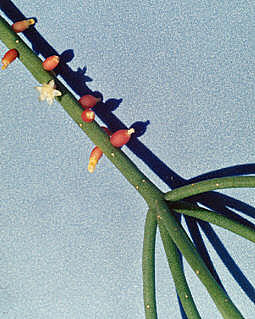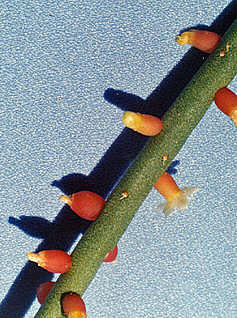

R. quellebambensis Johns. nomen nudum.
Reduced to synonymy under R. baccifera ss. baccifera by Barthlott and Taylor Bradleya 13Info from Backeberg’s Lexicon 1975
Body. similar to R. cassutha;
Fruit. intense red.
Habitat - Peru.
Comment by Backeberg: A good spec. on the basis of these characters alone, so that it merits a full description
A black and white photo in a B&W version of Exotica
has a description as follows:
(Peru) , epiphytic cactus with pendant thin cylindrical branches, dull
green with occasional purple markings and lightly grooved; glossy carmine-red
berry-like fruit at the tips.
Notes made April 2011 by Derek Butcher
We know that Wikipedia records this as Rhipsalis Quellebambensis
J Mill Stearn BUT did they bother to check their erroneous detail?
First there is no Quellebamba in Peru but there is a Quillabamba near
Cuzco. What does J Mill Stearn mean? Taxonomy rules are quite explicit
as to their meaning. We do know that Bartlott & Taylor treated R.
quellebambensis as a synonym of R. baccifera which can be
correctly cited as Rhipsalis baccifera (J S Mueller) Stearn.
Does this look familiar?
The only published record of this species is that given above and we guess
that the Johns. quoted by Backeberg is a shortened version of Johnson
and links to a catalogue name from the well known Cactus nursery of Harry
Johnson’s in California in the 1960s and 1970s. If anyone can advise
further it would be greatly appreciated.
Let us now look at some facts. In 1984 Karel Knize of Lima, Peru offered
KK#11 in his seed catalogue with the note - species Cuzco, var. quillabamba.
Derek Butcher, one of the authors of this website, bought some and grew
them to maturity. They flowered like R. baccifera AND had red berries.
It was assumed at the time that this was the elusive undescribed R.
quellebambensis even though the spelling was in possible error.
In 1988 Karel Knize offered seed of species Cuzco/Pisac but these turned
out to be almost identical to our red berried Rhipsalis quellebambensis.
While I appreciate the urge of nurserymen to sell something rare, taxonomists
are agreed that this plant is too obscure to be properly described and
named. As such it should remain as unidentified.